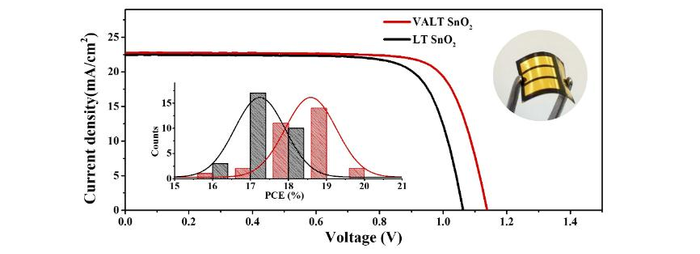Immense interest has been gained around flexible solar cells due to their excellent lightweight, portable and flexible properties. Such features provide promise for applications in areas such as wearable power sources, aerospace and building-integrated photovoltaics.
 Utilizing the vacuum-assisted annealing method in SnO2 electron transport layer fabrication at low temperature (100 °C), the remarkable open circuit voltage (1.14 V) and efficiency (20.14%) are achieved for perovskite solar cells with PET flexible substrates. Image Credit: Journal of Energy Chemistry.
Utilizing the vacuum-assisted annealing method in SnO2 electron transport layer fabrication at low temperature (100 °C), the remarkable open circuit voltage (1.14 V) and efficiency (20.14%) are achieved for perovskite solar cells with PET flexible substrates. Image Credit: Journal of Energy Chemistry.
Perovskite is known to be a perfect material for making flexible solar cells since the majority of the perovskite thin films and matched hole transport layers (HTLs) could be fabricated at low temperatures (<150 °C). But for the electron transport layer (ETL) to raise the conductivity and crystallinity of SnO2, a comparatively high temperature is normally needed (>180 °C).
A high temperature similar to this will result in the deformation of flexible substrates. Thus, one bottleneck for highly efficient flexible perovskite solar cells (f-PSCs) is to identify high-quality ETLs at low temperatures.
In recent times, a group headed by Professor Yiqiang Zhan from Fudan University achieved high-efficiency f-PSCs by tempering a SnO2 ETL in a rough vacuum at a low temperature (100 °C), and the best f-PSCs efficiency of 20.14% was achieved. SnO2 layers that have been made using this technique have displayed greater hydrophobicity and roughness when compared to samples made in an air atmosphere and temperatures of 100 °C.
This results in an enhanced ETL or perovskite interface connection and decreased defects in the SnO2 or perovskite interface. The correct density of oxygen vacancies on the surface during this treatment could be accountable for greater conductivity, which is considered to be useful for charge transfer.
This study indicates that, besides high-temperature annealing, the control of oxygen partial pressure is also efficient in realizing high conductivity for metal oxides, even at low temperatures, which seems to be significant for flexible electronics.
While a vacuum-assisted annealing technique in SnO2 electron transport layer fabrication at a low temperature (100 °C) was used in this study, exceptional efficiency (20.14%) and open-circuit voltage (1.14 V) were obtained for PSCs with polyethylene terephthalate flexible substrates.
Journal Reference:
Li, X., et al. (2021) Highly efficient flexible perovskite solar cells with vacuum-assisted low-temperature annealed SnO2 electron transport layer. Journal of Energy Chemistry. doi.org/10.1016/j.jechem.2021.09.021.